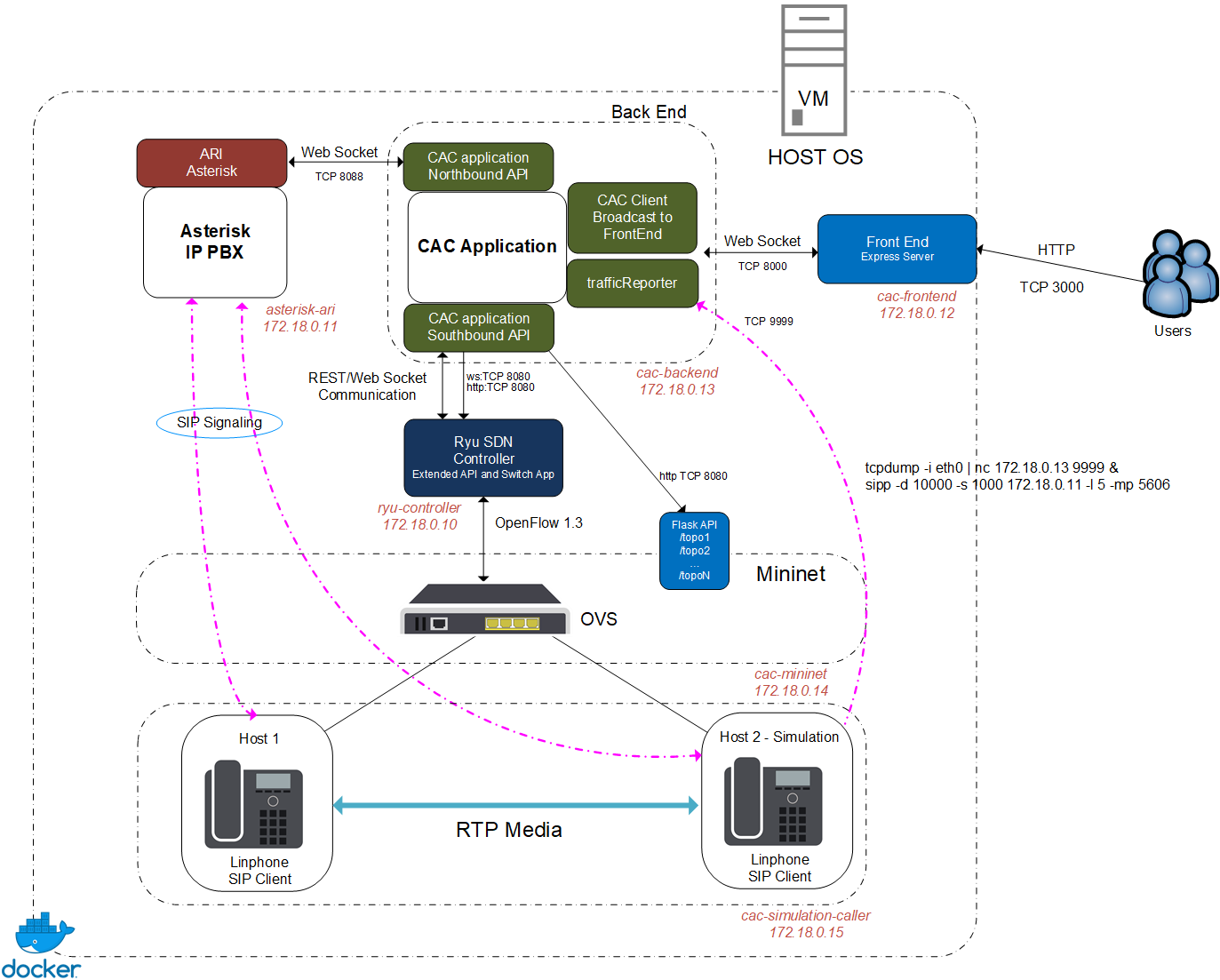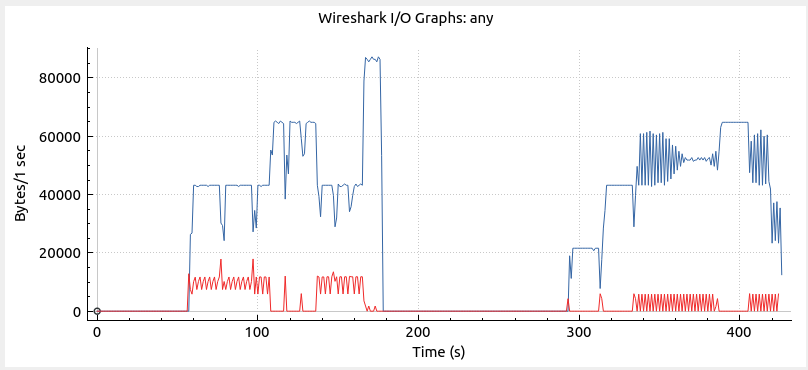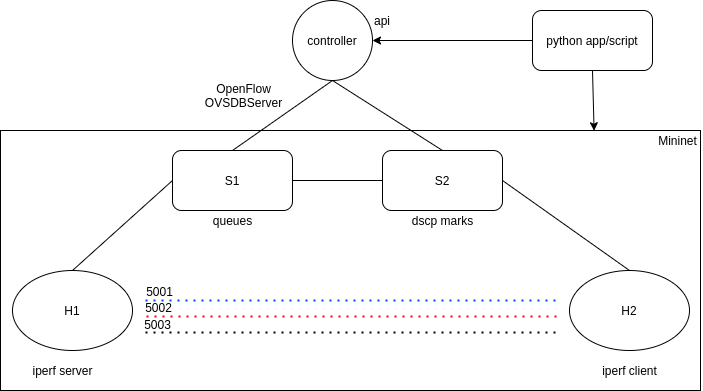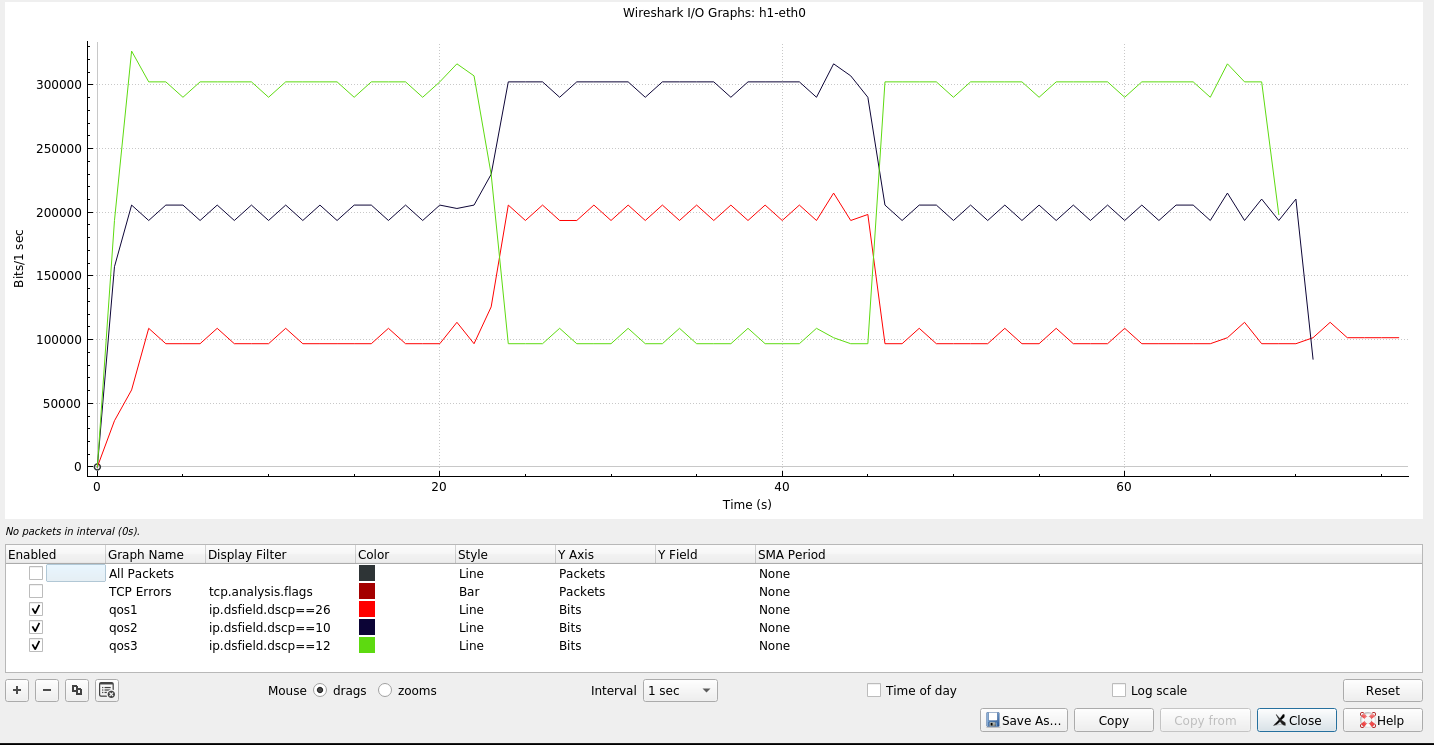Implementation of quality of service and call admission control features within sdn network. This implementation use Ryu Framework (https://ryu-sdn.org/) to develop controller applications based on OpenFlow v1.3. Features are integrated with an Asterisk service through ARI API via websockets+rest. Application behaviour is exposed via a basic Front End service developed with node.js.
Application architecture is shown in the figure below.
Table of contents
Some of the requirements to run this project simulations and stack are:
- Ryu Framework
- Mininet
- GNS3
- OpenVirtualSwitch (aka: OVS)
- Docker
- Docker-compose
- Python3
Clone repository
$ git clone git@github.com:joagonzalez/sdn-qos.git
$ mkproject sdn-qos
$ workon sdn-qos
$ pip install -r requirements.txt within each python serviceDirectory structure of application
.
├── application
│ ├── asterisk
│ │ └── conf
│ ├── call-admission-control
│ │ └── src
│ │ ├── backend
│ │ │ ├── libs
│ │ │ └── src
│ │ ├── frontend
│ │ │ └── src
│ │ └── mocks
│ │ ├── ari
│ │ └── ryu
│ ├── conf
│ │ ├── ari.conf
│ │ ├── extensions.conf
│ │ └── sip.conf
│ ├── mininet
│ │ └── topologies
│ ├── ryu
│ │ └── applications
│ └── simulation
└── documentation
├── architecture
│ ├── diagrams
│ │ └── Paper diagrams
│ └── modules
│ ├── astersik
│ │ ├── conf
│ │ └── scripts
│ └── ryu
│ ├── api
│ └── scripts
└── mockups
34 directories
# for each service
docker build -t <service> .# for each service
docker service create --network sdn-qos --publish <PORT-EXT:PORT-INT> --name <SERVICE> Run application simulation
cd application
docker-compose -f docker-compose-simulation.yml up -d
docker ps
open http://localhost:3000Some environment variables can be configured in order to modify simulation behavior.
backend: we can choose which cac algorithm to use
environment:
CAC_VERSION: v2 # CAC algorithm version [v1, v2]
The first simulation patterns belongs to the first non optimal algorithm. The second one is the v2 algorithm with optimal resource usage.
simulation: we can chosse how much time before sipp begins with calls, therefore enough time is given in order to access frontend web gui and having a correct call counting from the begining. On the other hand, we can choose which simulation patter to run [v1, v2], check simulation-setup.sh script for more information.
environment:
SIMULATION: v1 # Simulation pattern [v1, v2]
TIME: 15 # Time before sipp begins with calls
Run QoS simulation
Script sdn-qos-RealTimeQueues.py implements an automated test where packet prioritization could be achieve using ryu controller with mininet and ovs.
Run locally installed Ryu framework
workon ryu
python3 ./bin/ryu-manager --observe-links ryu.app.rest_topology ryu.app.ws_topology ryu.app.ofctl_rest ryu.app.qos_simple_switch_13_CAC ryu.app.qos_simple_switch_rest_13_CAC ryu.app.rest_conf_switch ryu.app.rest_qos ryu.app.gui_topology.gui_topology
Run mininet script
cd application/mininet
sudo python2.7 sdn-qos-RealTimeQueues.py Results
Run application with external infrastructure
External components (Asterisk, OVS, SIP Clients) are not included within docker-compose.yml.
cd application
docker-compose -f docker-compose.yml up -d
docker ps
open http://localhost:3000Then, you will have to update configuration file in application/call-admission-control/src/backend/src/config/settings.py. Specifically, asterisk data.
config = {
"ari": {
"host": "http://asterisk:8088/",
"username": "asterisk",
"password": "asterisk",
},
"ryu": {
"baseurl": "http://ryu:8080",
},
"frontService": {
"host": "call_admission_control_backend",
"listen": 8000
},
"client": {
"baseurl": "ws://call_admission_control_backend:8000",
}
}









